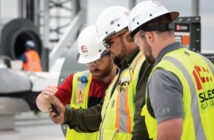
TEXO SAFETY DIRECTOR
COVID-19 & STRESS
As some may be aware, I started my career in Environmental Health and Safety in the oil & gas and coal mining industries. Looking back in these areas, you will see a consistent trend of decreased production every four to six years, and I have personally been involved with at least three of those downturns in my career. During these times, people are drastically laid off, more work is loaded on less staff, smaller companies are closed – many people are affected financially, physically, and mentally.
Again, as I write this article, we are feeling a huge downturn in oil and gas. In fact, a barrel of oil is less than the ever-sought-after toilet paper these days! While this time I am now in the construction industry and we are facing another enemy – the COVID-19 pandemic – I am definitely experiencing some deja vu.
The coronavirus is presenting new and unique challenges, and the nature of work is changing at a whirlwind speed. Many are teleworking full time for the first time, homeschooling children, and are isolated from co-workers, friends, and family. Our daily living routines are being disrupted, naturally causing added anxiety and stress physically, mentally, and financially.
Job stress and financial stress pose a threat to the health of our workers and, in turn, to the health of our organizations. We are navigating unchartered waters, making it important to find new ways to work and interact while also taking care of our mental health, physical health, and overall well-being. As we protect ourselves against potential exposure to the coronavirus, it is also a time for Mind, Body, and Soul Safety.
EFFECTS OF STRESS
Stress sets off an alarm in the brain, which responds by preparing the body for defensive action. The nervous system is aroused, and hormones are released to sharpen the senses, quicken the pulse, deepen respiration, and tense the muscles. This response (sometimes called “fight or flight”) is important because it helps us defend against threatening situations and is preprogrammed biologically. Everyone responds in much the same way, regardless of whether the stressful situation is at work or home.
In the past 20 years, many studies have looked at the relationship between job stress and a variety of ailments. Mood, sleep disturbances, upset stomach and headache, and disturbed relationships with family and friends are examples of stress-related problems that are quick to develop and are commonly seen in these studies.
These early signs of job stress are usually easy to recognize. But the effects of job stress on chronic diseases are more difficult to see because chronic diseases take a long time to develop and can be influenced by many other factors. Nonetheless, evidence is rapidly accumulating to suggest that stress plays an important role in several types of chronic health problems – especially cardiovascular disease, musculoskeletal disorders, and psychological disorders.

EMPLOYEE MENTAL HEALTH
The Center for Workplace Mental Health says that 1 in 5 adults will experience a diagnosable mental illness in any given year. Of those, more than half will go untreated. Disorders such as anxiety, depression, and ADHD can take a toll on someone’s day-to-day quality of life and work. An employee dealing with such disorders may struggle to participate in social aspects at work, concentrate on one task at a time, or put their full attention and effort into daily tasks, and they often feel like they can’t bring their mental health needs to their employer’s attention.
Mental health is as important as physical health, which is a huge factor when talking workplace health and safety. In fact, healthcare expenditures are nearly 50 percent greater for workers who report high levels of stress, according to the Journal of Occupational and Environmental Medicine. Therefore, the acknowledgment, respect, and treatment of mental illnesses should be an equally high priority for employers, especially since a person’s mental health can have a significant impact on their professional performance.
Treatment for mental illness works. It is costeffective, increases productivity, lowers absenteeism and overall good for business. More than 80 percent of those treated for a diagnosable mental illness reported improved levels of work efficacy and satisfaction. Employee quality of life cannot be high when mental health is not acknowledged and treated.
The foundation of an effective workplace is the quality of life found there. Whether or not one’s occupation is the root of their mental health struggle, it is an employer’s job to understand that mental health has an impact on individual’s lives as a whole and that access to help can make for a healthier, more productive employee and a safer work environment overall.
EMPLOYERS’ RESPONSE
According to a study by The Anxiety and Depression Association of America, around half of employees whose stress interferes with work have not brought it to their employer’s attention out of fear. Thirty-four percent feared their boss would interpret their stress and anxiety as an unwillingness to do the activity, 31 percent feared being labeled weak, 22 percent feared it would affect promotion opportunities and it would go into their file, and 20 percent feared not being taken seriously.
The mental health stigma should have no place in a healthy and safe work environment. Part of safety in the workplace is ensuring each employee feels safe enough to express their needs and when they need help. This is true Mind, Body and Soul Safety! Every employee should feel confident and comfortable enough to discuss any mental health issues with their employer, especially if they are seeking help.
With many organizations requiring employees to stay out of the office, it’s more important than ever to encourage and facilitate regular communication with employees. Here are tips for managers and human resource professionals in supporting employees in staying connected to the workplace and each other:
- Stay connected with communication and meeting tools. Use virtual meeting options with video, such as Zoom or JoinMe, for regular check-ins and to allow teams to connect with one another “face-to-face.”
- Show empathy and be available. Understand that employees are likely feeling overwhelmed and anxious about circumstances related to the coronavirus. Make yourself available to your staff to talk about fears, to answer questions and to reassure them about work and other issues that might come up.
- Recognize the impact of isolation and loneliness. Working remotely can cause people to feel isolated, making it more important to routinely check in with your team not only about their work product, but also to see how they are doing. Loneliness can lead to depression and other mental health issues. Be aware of significant changes you may see in your team member’s personality or work product because it may be a sign that a person is struggling.
- Check in with your EAP and Health Plan. Check in with your Employee Assistance Program (EAP) to confirm their availability and to coordinate support for employees. Remind the staff that the EAP is there if they need support and can connect employees with behavioral health support, if needed. Also, connect with the organization’s health plan(s) to learn what they are offering to support plan members and pass that information onto employees. Be sure to include all relevant website links and phone numbers for both the EAP and health plan in communicating with employees.
- Discuss the need for mindfulness and improve situational awareness. With this pandemic, we all may need a renewed daily focus. Many workplace injuries or accidents that are not musculoskeletal in nature can be linked to lack of awareness or focus (e.g., slips, trips, falls, or caught-in and struck-by scenarios). Mindfulness coaching is a way to improve a worker’s focus and attention by learning to recognize inattentiveness and become aware in the present real time environment.
Managers have an important role in establishing order, predictability, and direction during largescale disasters. As the national and organizational responses continue to unfold, your own sense of calm, focus, and self-assurance will play a significant role in easing the stress of those you work with. Because this is an extended, infrequent event, it may be helpful to remember that organizational strategies must change. Plan your approach before you respond. First, gather and prepare accurate and up-to-date information, determine the impact on your staff carefully, and organize your own thoughts.
Be sure to convey that the organization will prioritize the safety of all staff, work with them to understand their questions and needs, and explain any policies or regulations. Again, it’s completely natural for this disruption and uncertainty to lead to anxiety and stress. Now more than ever, we all must take care of ourselves, our mental health and well-being, and our safety together as a team on our projects and in our workplaces with Mind, Body, Soul and Safety!



